UAV-Borne Imagery Can Supplement Airborne Lidar in the Precise Description of Dynamically Changing Shrubland Woody Vegetation
Abstract
:1. Introduction
2. Materials and Methods
2.1. Study Sites
2.2. ALS, UAV, and Airborne Imagery Data Acquisition
2.3. Processing of Input Remote Sensing Data
2.4. Normalized Digital Surface Model (NDSM) Calculation
2.5. Woody Plant Structure Analysis
2.6. Statistical Analysis
3. Results
3.1. The Number of Detected Woody Plant Individuals
3.2. Woody Vegetation Height Detection
4. Discussion
4.1. The Number of Detected Woody Plant Individuals
4.2. Woody Vegetation Height Detection
4.3. Tree vs. Shrub Height Accuracy and Detection Success
4.4. UAV-Based DSM and ALS-Based DTM Fusion
4.5. Landscape/Vegetation Patterns Classification
5. Conclusions
Author Contributions
Funding
Data Availability Statement
Acknowledgments
Conflicts of Interest
Appendix A
| ALSHD | AImg | AImg-ALSLD | AImg-ALSHD | UAV | UAV-ALSLD | UAV-ALSHD | ||
|---|---|---|---|---|---|---|---|---|
| Site 01 | Detected | 1183 | 596 | 799 | 802 | 1164 | 1018 | 1138 |
| Reference | 1214 | 1214 | 1214 | 1214 | 1214 | 1214 | 1214 | |
| True | 1128 | 499 | 612 | 610 | 840 | 790 | 833 | |
| Omission | 86 | 715 | 602 | 604 | 374 | 424 | 381 | |
| Commission | 55 | 97 | 187 | 192 | 324 | 228 | 305 | |
| Accuracy (%) | 92.9 | 41.1 | 50.4 | 50.3 | 69.2 | 65.1 | 68.6 | |
| Site 02 | Detected | 976 | 508 | 653 | 636 | 815 | 849 | 828 |
| Reference | 946 | 946 | 946 | 946 | 946 | 946 | 946 | |
| True | 898 | 444 | 468 | 447 | 617 | 656 | 661 | |
| Omission | 48 | 502 | 478 | 499 | 329 | 290 | 285 | |
| Commission | 78 | 64 | 185 | 189 | 198 | 193 | 167 | |
| Accuracy (%) | 94.9 | 46.9 | 49.5 | 47.2 | 65.2 | 69.3 | 69.9 | |
| Site 03 | Detected | 1256 | 369 | 949 | 886 | 1096 | 1001 | 1224 |
| Reference | 1215 | 1215 | 1215 | 1215 | 1215 | 1215 | 1215 | |
| True | 1200 | 301 | 653 | 628 | 787 | 780 | 914 | |
| Omission | 15 | 914 | 562 | 587 | 428 | 435 | 301 | |
| Commission | 56 | 68 | 296 | 258 | 309 | 221 | 310 | |
| Accuracy (%) | 98.8 | 24.8 | 53.7 | 51.7 | 64.8 | 64.2 | 75.2 | |
| Site 04 | Detected | 1016 | 603 | 799 | 851 | 1133 | 1582 | 1304 |
| Reference | 1023 | 1023 | 1023 | 1023 | 1023 | 1023 | 1023 | |
| True | 972 | 430 | 551 | 552 | 688 | 705 | 669 | |
| Omission | 51 | 593 | 472 | 471 | 335 | 318 | 354 | |
| Commission | 44 | 173 | 248 | 299 | 445 | 877 | 635 | |
| Accuracy (%) | 95.0 | 42.0 | 53.9 | 54.0 | 67.3 | 68.9 | 65.4 | |
| Site 05 | Detected | 842 | 464 | 775 | 633 | 975 | 851 | 791 |
| Reference | 825 | 825 | 825 | 825 | 825 | 825 | 825 | |
| True | 794 | 370 | 472 | 460 | 669 | 636 | 629 | |
| Omission | 31 | 455 | 353 | 365 | 156 | 189 | 196 | |
| Commission | 48 | 94 | 303 | 173 | 306 | 215 | 162 | |
| Accuracy (%) | 96.2 | 44.8 | 57.2 | 55.76 | 81.1 | 77.1 | 76.2 | |
| Site 06 | Detected | 853 | 436 | 442 | 631 | 852 | 959 | 943 |
| Reference | 831 | 831 | 831 | 831 | 831 | 831 | 831 | |
| True | 767 | 383 | 368 | 415 | 555 | 588 | 584 | |
| Omission | 64 | 448 | 463 | 416 | 276 | 243 | 247 | |
| Commission | 86 | 53 | 74 | 216 | 297 | 371 | 359 | |
| Accuracy (%) | 92.3 | 46.1 | 44.2 | 49.9 | 66.8 | 70.8 | 70.3 | |
| Overall | Detected | 6126 | 2976 | 4237 | 4439 | 6035 | 6260 | 6228 |
| Reference | 6054 | 6054 | 6054 | 6054 | 6054 | 6054 | 6054 | |
| True | 5759 | 2427 | 3124 | 3112 | 4156 | 4155 | 4209 | |
| Omission | 295 | 3627 | 2988 | 2942 | 1898 | 1899 | 1764 | |
| Commission | 367 | 549 | 1171 | 1327 | 1879 | 2105 | 1938 | |
| Accuracy (%) | 95.1 | 40.1 | 51.6 | 51.4 | 68.7 | 68.6 | 70.9 |
Appendix B

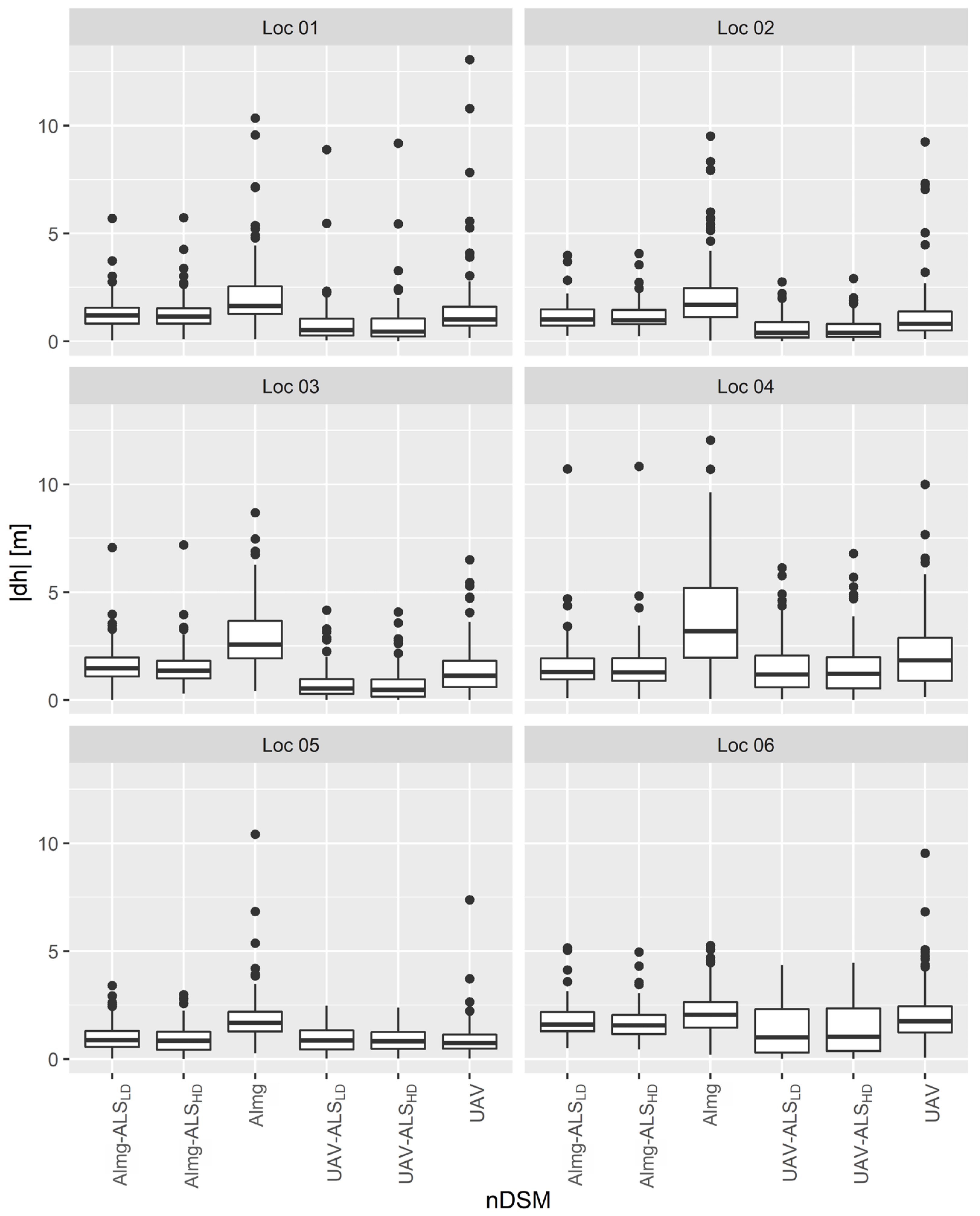
Appendix C
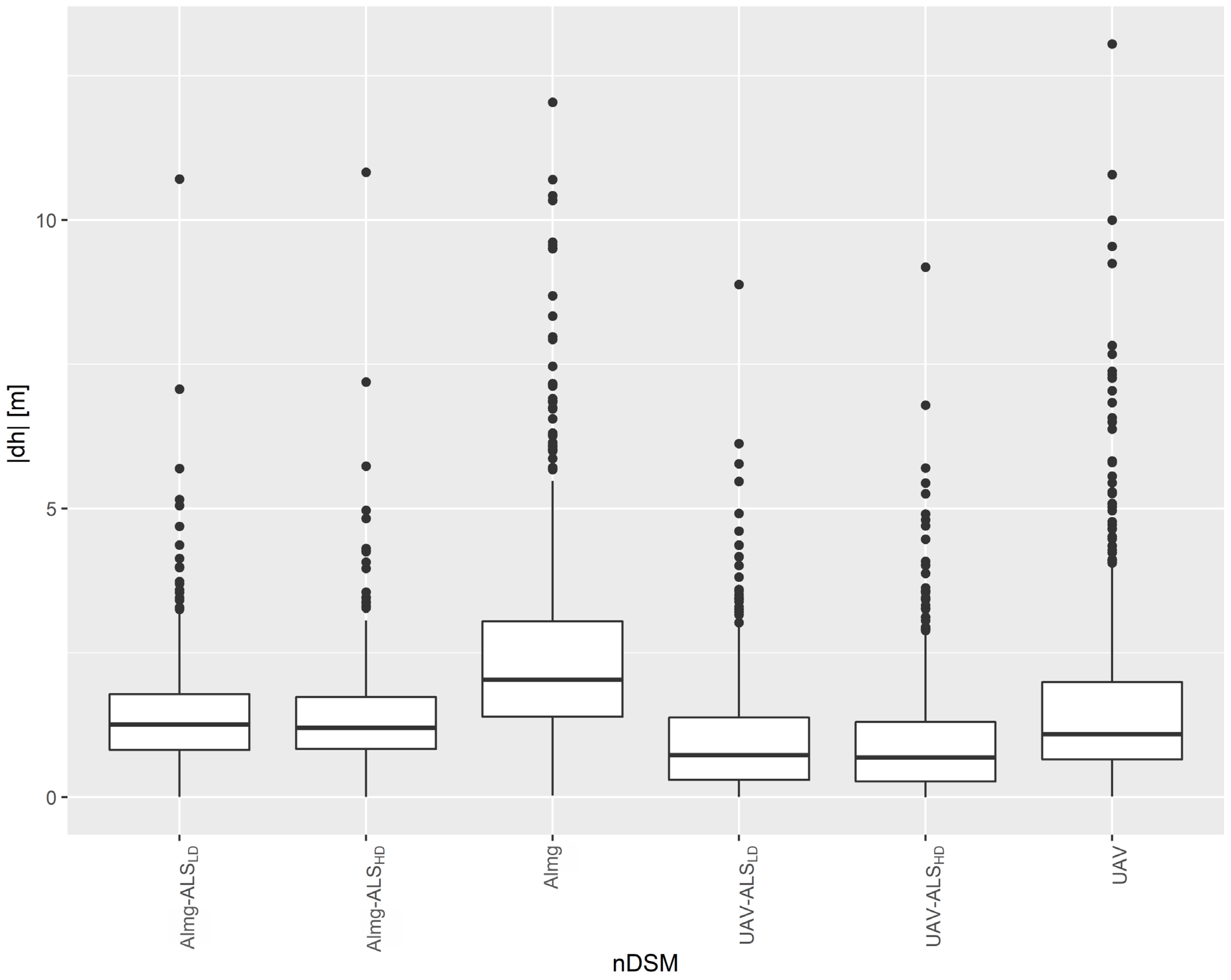
References
- Panagiotidis, D.; Abdollahnejad, A.; Surový, P.; Chiteculo, V. Determining Tree Height and Crown Diameter from High-Resolution UAV Imagery. Int. J. Remote Sens. 2017, 38, 2392–2410. [Google Scholar] [CrossRef]
- Lelli, C.; Bruun, H.H.; Chiarucci, A.; Donati, D.; Frascaroli, F.; Fritz, Ö.; Goldberg, I.; Nascimbene, J.; Tøttrup, A.P.; Rahbek, C.; et al. Biodiversity Response to Forest Structure and Management: Comparing Species Richness, Conservation Relevant Species and Functional Diversity as Metrics in Forest Conservation. For. Ecol. Manag. 2019, 432, 707–717. [Google Scholar] [CrossRef]
- Bohn, F.J.; Huth, A. The Importance of Forest Structure to Biodiversity-Productivity Relationships. R. Soc. Open Sci. 2017, 4, 160521. [Google Scholar] [CrossRef] [PubMed] [Green Version]
- Matsumoto, H.; Ohtani, M.; Washitani, I. Tree Crown Size Estimated Using Image Processing: A Biodiversity Index for Sloping Subtropical Broad-Leaved Forests. Trop. Conserv. Sci. 2017, 10, 1940082917721787. [Google Scholar] [CrossRef] [Green Version]
- Scherrer, D.; Massy, S.; Meier, S.; Vittoz, P.; Guisan, A. Assessing and Predicting Shifts in Mountain Forest Composition across 25 Years of Climate Change. Divers. Distrib. 2017, 23, 517–528. [Google Scholar] [CrossRef] [Green Version]
- Fujimoto, A.; Haga, C.; Matsui, T.; Machimura, T.; Hayashi, K.; Sugita, S.; Takagi, H. An End to End Process Development for UAV-SfM Based Forest Monitoring: Individual Tree Detection, Species Classification and Carbon Dynamics Simulation. Forests 2019, 10, 680. [Google Scholar] [CrossRef] [Green Version]
- Klouček, T.; Komárek, J.; Surový, P.; Hrach, K.; Janata, P.; Vašíček, B. The Use of UAV Mounted Sensors for Precise Detection of Bark Beetle Infestation. Remote Sens. 2019, 11, 1561. [Google Scholar] [CrossRef] [Green Version]
- Kašpar, V.; Hederová, L.; Macek, M.; Müllerová, J.; Prošek, J.; Surový, P.; Wild, J.; Kopecký, M. Temperature Buffering in Temperate Forests: Comparing Microclimate Models Based on Ground Measurements with Active and Passive Remote Sensing. Remote Sens. Environ. 2021, 263, 112522. [Google Scholar] [CrossRef]
- Getzin, S.; Nuske, R.S.; Wiegand, K. Using Unmanned Aerial Vehicles (UAV) to Quantify Spatial Gap Patterns in Forests. Remote Sens. 2014, 6, 6988–7004. [Google Scholar] [CrossRef] [Green Version]
- Lin, J.; Wang, M.; Ma, M.; Lin, Y. Aboveground Tree Biomass Estimation of Sparse Subalpine Coniferous Forest with UAV Oblique Photography. Remote Sens. 2018, 10, 1849. [Google Scholar] [CrossRef] [Green Version]
- Reif, J.; Marhoul, P.; Čížek, O.; Konvička, M. Abandoned Military Training Sites Are an Overlooked Refuge for At-Risk Open Habitat Bird Species. Biodivers. Conserv. 2011, 20, 3645–3662. [Google Scholar] [CrossRef]
- Carvajal-Ramírez, F.; da Silva, J.R.M.; Agüera-Vega, F.; Martínez-Carricondo, P.; Serrano, J.; Moral, F.J. Evaluation of Fire Severity Indices Based on Pre- and Post-Fire Multispectral Imagery Sensed from UAV. Remote Sens. 2019, 11, 993. [Google Scholar] [CrossRef] [Green Version]
- Bušek, O.; Reif, J. The Potential of Military Training Areas for Bird Conservation in a Central European Landscape. Acta Oecologica 2017, 84, 34–40. [Google Scholar] [CrossRef]
- Svenningsen, S.R.; Levin, G.; Perner, M.L. Military Land Use and the Impact on Landscape: A Study of Land Use History on Danish Defence Sites. Land Use Policy 2019, 84, 114–126. [Google Scholar] [CrossRef]
- Hamraz, H.; Contreras, M.A.; Zhang, J. Vertical Stratification of Forest Canopy for Segmentation of Understory Trees within Small-Footprint Airborne LiDAR Point Clouds. ISPRS J. Photogramm. Remote Sens. 2017, 130, 385–392. [Google Scholar] [CrossRef] [Green Version]
- Ganz, S.; Käber, Y.; Adler, P. Measuring Tree Height with Remote Sensing-a Comparison of Photogrammetric and LiDAR Data with Different Field Measurements. Forests 2019, 10, 694. [Google Scholar] [CrossRef] [Green Version]
- Komárek, J. The Perspective of Unmanned Aerial Systems in Forest Management: Do We Really Need Such Details? Appl. Veg. Sci. 2020, 23, 718–721. [Google Scholar] [CrossRef]
- White, J.C.; Wulder, M.A.; Vastaranta, M.; Coops, N.C.; Pitt, D.; Woods, M. The Utility of Image-Based Point Clouds for Forest Inventory: A Comparison with Airborne Laser Scanning. Forests 2013, 4, 518–536. [Google Scholar] [CrossRef] [Green Version]
- Puliti, S.; Dash, J.P.; Watt, M.S.; Breidenbach, J.; Pearse, G.D. A Comparison of UAV Laser Scanning, Photogrammetry and Airborne Laser Scanning for Precision Inventory of Small-Forest Properties. Forestry 2020, 93, 150–162. [Google Scholar] [CrossRef]
- Bergen, K.M.; Goetz, S.J.; Dubayah, R.O.; Henebry, G.M.; Hunsaker, C.T.; Imhoff, M.L.; Nelson, R.F.; Parker, G.G.; Radeloff, V.C. Remote Sensing of Vegetation 3-D Structure for Biodiversity and Habitat: Review and Implications for Lidar and Radar Spaceborne Missions. J. Geophys. Res. Biogeosci. 2009, 114, G00E06. [Google Scholar] [CrossRef] [Green Version]
- Khosravipour, A.; Skidmore, A.K.; Isenburg, M. Generating Spike-Free Digital Surface Models Using LiDAR Raw Point Clouds: A New Approach for Forestry Applications. Int. J. Appl. Earth Obs. Geoinf. 2016, 52, 104–114. [Google Scholar] [CrossRef]
- Khosravipour, A.; Skidmore, A.K.; Isenburg, M.; Wang, T.; Hussin, Y.A. Generating Pit-Free Canopy Height Models from Airborne Lidar. Photogramm. Eng. Remote Sens. 2014, 80, 863–872. [Google Scholar] [CrossRef]
- Bakx, T.R.M.; Koma, Z.; Seijmonsbergen, A.C.; Kissling, W.D. Use and Categorization of Light Detection and Ranging Vegetation Metrics in Avian Diversity and Species Distribution Research. Divers. Distrib. 2019, 25, 1045–1059. [Google Scholar] [CrossRef] [Green Version]
- Moudrý, V.; Klápště, P.; Fogl, M.; Gdulová, K.; Barták, V.; Urban, R. Assessment of LiDAR Ground Filtering Algorithms for Determining Ground Surface of Non-Natural Terrain Overgrown with Forest and Steppe Vegetation. Measurement 2020, 150, 107047. [Google Scholar] [CrossRef]
- Salach, A.; Bakula, K.; Pilarska, M.; Ostrowski, W.; Górski, K.; Kurczynski, Z. Accuracy Assessment of Point Clouds from LidaR and Dense Image Matching Acquired Using the UAV Platform for DTM Creation. ISPRS Int. J. Geo-Inf. 2018, 7, 342. [Google Scholar] [CrossRef] [Green Version]
- Wallace, L.; Bellman, C.; Hally, B.; Hernandez, J.; Jones, S.; Hillman, S. Assessing the Ability of Image Based Point Clouds Captured from a UAV to Measure the Terrain in the Presence of Canopy Cover. Forests 2019, 10, 284. [Google Scholar] [CrossRef] [Green Version]
- Klápště, P.; Fogl, M.; Barták, V.; Gdulová, K.; Urban, R.; Moudrý, V. Sensitivity Analysis of Parameters and Contrasting Performance of Ground Filtering Algorithms with UAV Photogrammetry-Based and LiDAR Point Clouds. Int. J. Digit. Earth 2020, 13, 1672–1694. [Google Scholar] [CrossRef]
- Klouček, T.; Lagner, O.; Šímová, P. How Does Data Accuracy Influence the Reliability of Digital Viewshed Models? A Case Study with Wind Turbines. Appl. Geogr. 2015, 64, 46–54. [Google Scholar] [CrossRef]
- Lagner, O.; Klouček, T.; Šímová, P. Impact of Input Data (in) Accuracy on Overestimation of Visible Area in Digital Viewshed Models. PeerJ 2018, 6, e4835. [Google Scholar] [CrossRef]
- Ke, Y.; Quackenbush, L.J. A Review of Methods for Automatic Individual Tree-Crown Detection and Delineation from Passive Remote Sensing. Int. J. Remote Sens. 2011, 32, 4725–4747. [Google Scholar] [CrossRef]
- Vauhkonen, J.; Ene, L.; Gupta, S.; Heinzel, J.; Holmgren, J.; Pitkänen, J.; Solberg, S.; Wang, Y.; Weinacker, H.; Hauglin, K.M.; et al. Comparative Testing of Single-Tree Detection Algorithms under Different Types of Forest. Forestry 2012, 85, 27–40. [Google Scholar] [CrossRef] [Green Version]
- Surový, P.; Almeida Ribeiro, N.; Panagiotidis, D. Estimation of Positions and Heights from UAV-Sensed Imagery in Tree Plantations in Agrosilvopastoral Systems. Int. J. Remote Sens. 2018, 39, 4786–4800. [Google Scholar] [CrossRef]
- Kuželka, K.; Slavík, M.; Surový, P. Very High Density Point Clouds from UAV Laser Scanning for Automatic Tree Stem Detection and Direct Diameter Measurement. Remote Sens. 2020, 12, 1236. [Google Scholar] [CrossRef] [Green Version]
- Antonello, A.; Franceschi, S.; Floreancig, V.; Comiti, F.; Tonon, G. Application of a Pattern Recognition Algorithm for Single Tree Detection from LiDAR Data. Int. Arch. Photogramm. Remote Sens. Spat. Inf. Sci. 2017, 42, 27–33. [Google Scholar] [CrossRef] [Green Version]
- Salamí, E.; Barrado, C.; Pastor, E. UAV Flight Experiments Applied to the Remote Sensing of Vegetated Areas. Remote Sens. 2014, 6, 11051–11081. [Google Scholar] [CrossRef] [Green Version]
- Torresan, C.; Berton, A.; Carotenuto, F.; Di Gennaro, S.F.; Gioli, B.; Matese, A.; Miglietta, F.; Vagnoli, C.; Zaldei, A.; Wallace, L. Forestry Applications of UAVs in Europe: A Review. Int. J. Remote Sens. 2017, 38, 2427–2447. [Google Scholar] [CrossRef]
- Komárek, J.; Klouček, T.; Prošek, J. The Potential of Unmanned Aerial Systems: A Tool towards Precision Classification of Hard-to-Distinguish Vegetation Types? Int. J. Appl. Earth Obs. Geoinf. 2018, 71, 9–19. [Google Scholar] [CrossRef]
- Chen, Q.; Baldocchi, D.; Gong, P.; Kelly, M. Isolating Individual Trees in a Savanna Woodland Using Small Footprint LIDAR Data Isolating Individual Trees in a Savanna Woodland Using Small Footprint Lidar Data. Photogramm. Eng. Remote Sens. 2006, 72, 923–932. [Google Scholar] [CrossRef] [Green Version]
- Koch, B.; Heyder, U.; Weinacker, H. Detection of Individual Tree Crowns in Airborne Lidar Data. Photogramm. Eng. Remote Sens. 2006, 72, 357–363. [Google Scholar] [CrossRef] [Green Version]
- Popescu, S.C.; Wynne, R.H.; Nelson, R.F. Estimating Plot-Level Tree Heights with Lidar: Local Filtering with a Canopy-Height Based Variable Window Size. Comput. Electron. Agric. 2002, 37, 71–95. [Google Scholar] [CrossRef]
- Mohan, M.; Silva, C.A.; Klauberg, C.; Jat, P.; Catts, G.; Cardil, A.; Hudak, A.T.; Dia, M. Individual Tree Detection from Unmanned Aerial Vehicle (UAV) Derived Canopy Height Model in an Open Canopy Mixed Conifer Forest. Forests 2017, 8, 340. [Google Scholar] [CrossRef] [Green Version]
- Liu, J.; Shen, J.; Zhao, R.; Xu, S. Extraction of Individual Tree Crowns from Airborne LiDAR Data in Human Settlements. Math. Comput. Model. 2013, 58, 524–535. [Google Scholar] [CrossRef]
- Nevalainen, O.; Honkavaara, E.; Tuominen, S.; Viljanen, N.; Hakala, T.; Yu, X.; Hyyppä, J.; Saari, H.; Pölönen, I.; Imai, N.N.; et al. Individual Tree Detection and Classification with UAV-Based Photogrammetric Point Clouds and Hyperspectral Imaging. Remote Sens. 2017, 9, 185. [Google Scholar] [CrossRef] [Green Version]
- Tuominen, S.; Balazs, A.; Honkavaara, E.; Pölönen, I.; Saari, H.; Hakala, T.; Viljanen, N. Hyperspectral UAV-Imagery and Photogrammetric Canopy Height Model in Estimating Forest Stand Variables. Silva Fenn. 2017, 51, 7721. [Google Scholar] [CrossRef] [Green Version]
- Puliti, S.; Ørka, H.O.; Gobakken, T.; Næsset, E. Inventory of Small Forest Areas Using an Unmanned Aerial System. Remote Sens. 2015, 7, 9632–9654. [Google Scholar] [CrossRef] [Green Version]
- Wallace, L.; Lucieer, A.; Malenovsky, Z.; Turner, D.; Vopenka, P. Assessment of Forest Structure Using Two UAV Techniques: A Comparison of Airborne Laser Scanning and Structure from Motion (SfM) Point Clouds. Forests 2016, 7, 62. [Google Scholar] [CrossRef] [Green Version]
- Zarco-Tejada, P.J.; Diaz-Varela, R.; Angileri, V.; Loudjani, P. Tree Height Quantification Using Very High Resolution Imagery Acquired from an Unmanned Aerial Vehicle (UAV) and Automatic 3D Photo-Reconstruction Methods. Eur. J. Agron. 2014, 55, 89–99. [Google Scholar] [CrossRef]
- Díaz-Varela, R.A.; de la Rosa, R.; León, L.; Zarco-Tejada, P.J. High-Resolution Airborne UAV Imagery to Assess Olive Tree Crown Parameters Using 3D Photo Reconstruction: Application in Breeding Trials. Remote Sens. 2015, 7, 4213–4232. [Google Scholar] [CrossRef] [Green Version]
- Müllerová, J.; Brůna, J.; Bartaloš, T.; Dvořák, P.; Vítková, M.; Pyšek, P. Timing Is Important: Unmanned Aircraft vs. Satellite Imagery in Plant Invasion Monitoring. Front. Plant Sci. 2017, 8, 887. [Google Scholar] [CrossRef] [Green Version]
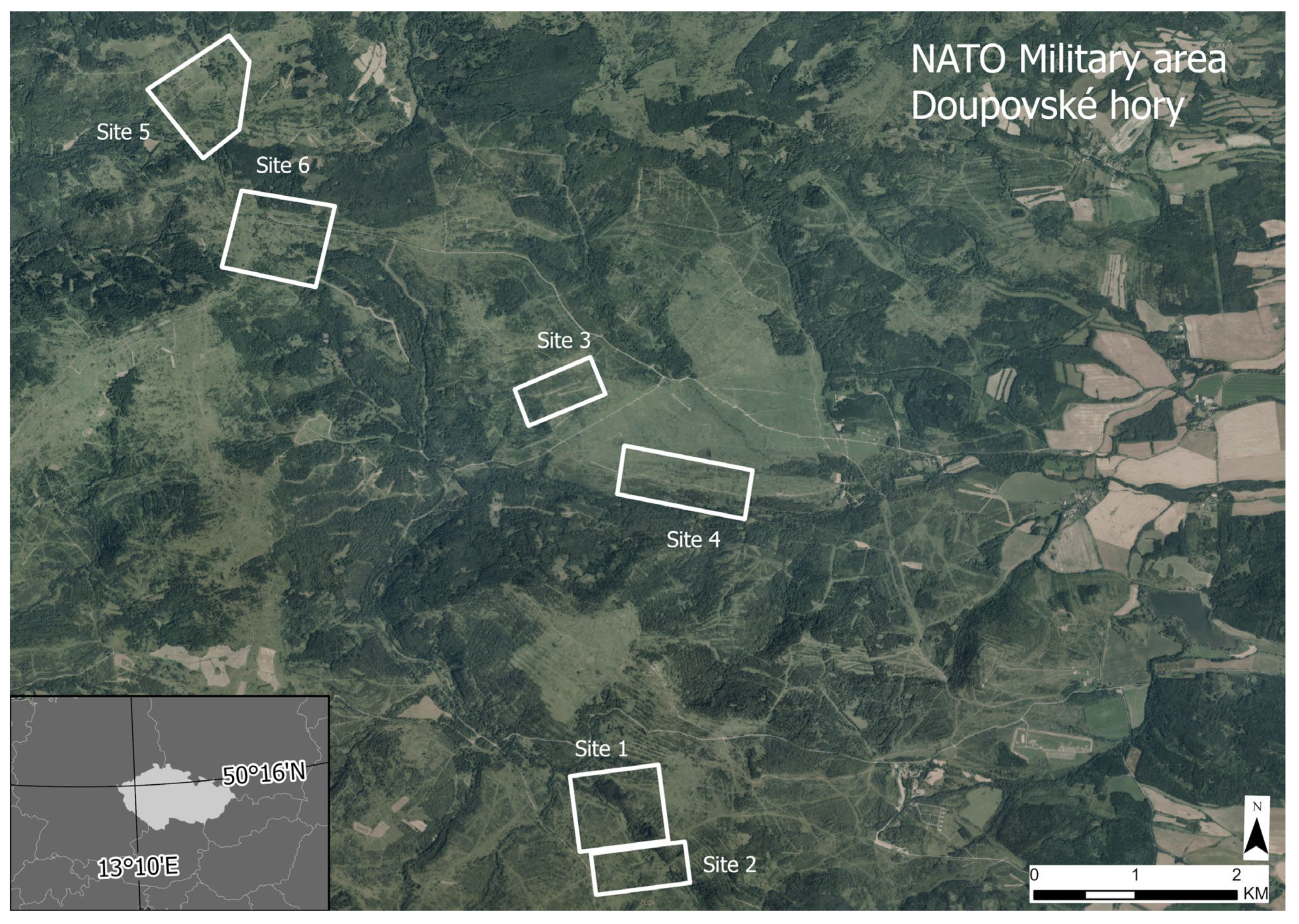
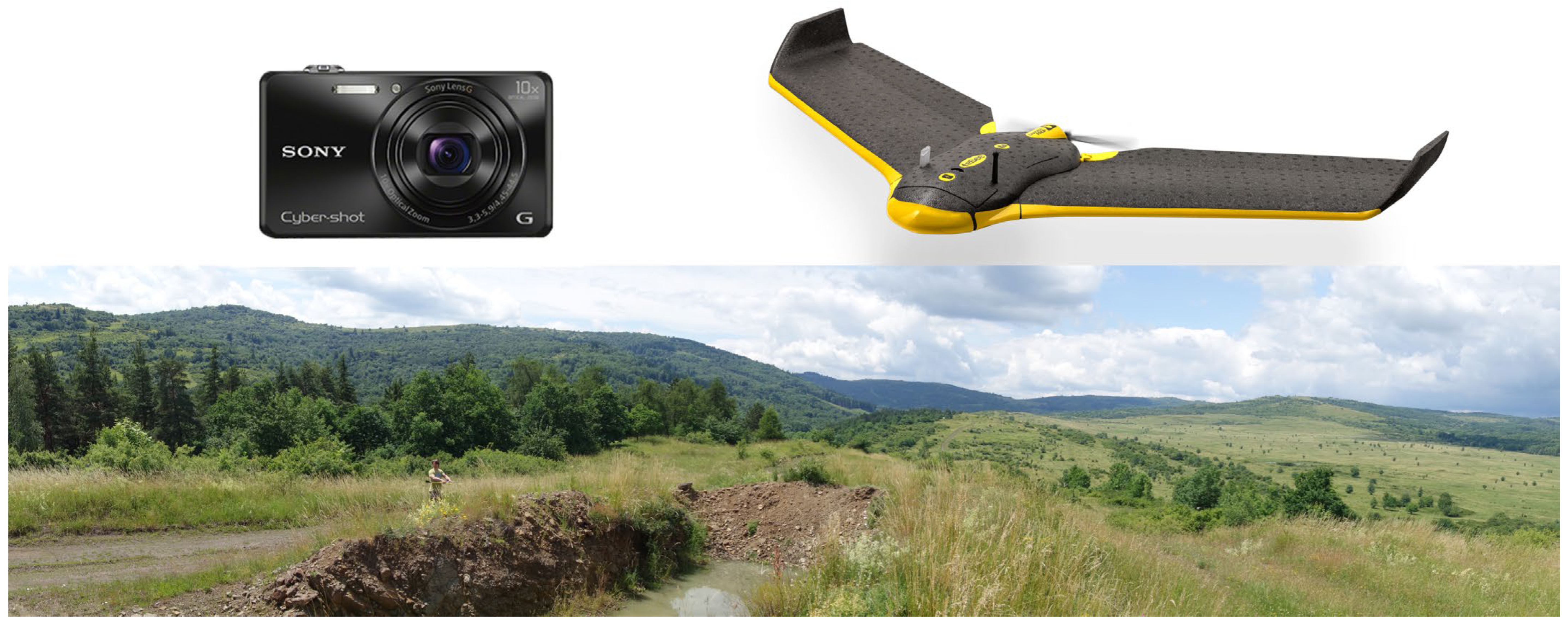

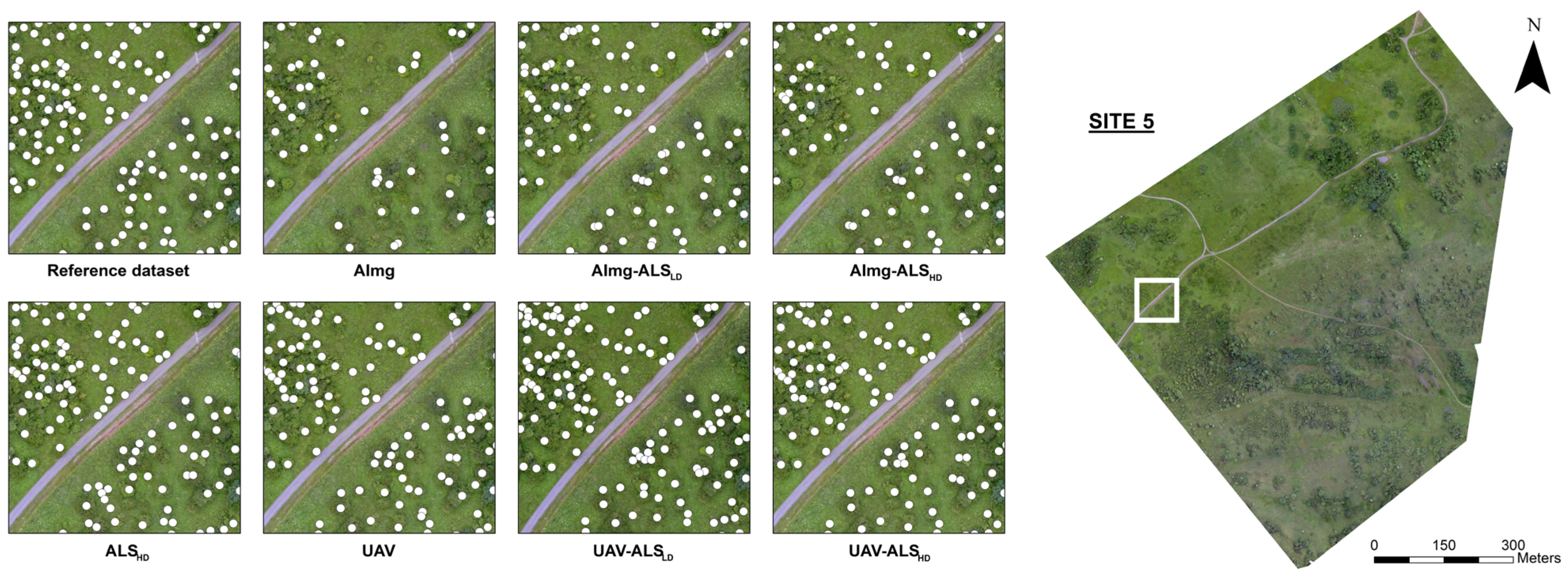
| Site | Elevation (m amsl) * | Mean Slope (°) | Woody Vegetation Cover (%) ** | Woody Vegetation Height (m) *** | Total Area (ha) |
|---|---|---|---|---|---|
| Site 01 | 555–645 | 9.6 (6.6) | 33.2 | 7.5 (6.4) | 66.5 |
| Site 02 | 579–635 | 6.8 (5.4) | 28.5 | 5.6 (4.6) | 36.7 |
| Site 03 | 513–587 | 9.6 (5.2) | 20.9 | 3.8 (2.1) | 31.9 |
| Site 04 | 423–492 | 7.8 (7.0) | 27.8 | 8.4 (6.4) | 62.6 |
| Site 05 | 684–742 | 6.2 (3.4) | 26.4 | 5.9 (4.2) | 68.4 |
| Site 06 | 653–745 | 7.2 (3.5) | 33.9 | 9.4 (6.0) | 75.4 |
| Remote Sensing Data | Date of Acquisition | Resolution | Data Type | Data Extent (km2) |
|---|---|---|---|---|
| Airborne Laser Scanning—HD | 17 September 2016 | 0.21 m 20 pts/m2 | Elevation Raster Point Cloud | 216 |
| Airborne Imagery | 17 September 2016 | 0.94 m 40 pts/m2 | High resolution images Point Cloud | 216 |
| Airborne Laser Scanning—LD | March 2011; available since 2016 | 2 m 1–2 pts/m2 | Elevation Raster Point Cloud | 78,000 |
| Unmanned Aerial Vehicle | 27 June 2016 | 0.15 m 260 pts/m2 | Very high resolution images Point Cloud | 3.5 |
| Name of NDSM | DSM | DTM | List of Acronyms |
|---|---|---|---|
| ALSHD | ALSHD | ALSHD | ALSHD: Airborne Laser Scanning—High Density ALSLD: Airborne Laser Scanning—Low Density AImg: Airborne Imagery UAV: Unmanned Aerial Vehicle |
| AImg | AImg | AImg | |
| AImg-ALSLD | AImg | ALSLD | |
| AImg-ALSHD | AImg | ALSHD | |
| UAV | UAV | UAV | |
| UAV-ALSLD | UAV | ALSLD | |
| UAV-ALSHD | UAV | ALSHD |
| Site | ALSHD | AImg | AImg-ALSLD | AImg-ALSHD | UAV | UAV-ALSLD | UAV-ALSHD | |
|---|---|---|---|---|---|---|---|---|
| Site 01 | Apparent success rate | 97.5 | 49.1 | 65.8 | 66.1 | 95.9 | 83.9 | 93.7 |
| Adjusted success rate | 92.9 | 41.1 | 50.4 | 50.3 | 69.2 | 65.1 | 68.6 | |
| Site 02 | Apparent success rate | 103.2 | 53.7 | 69 | 67.2 | 86.2 | 89.8 | 87.5 |
| Adjusted success rate | 94.9 | 46.9 | 49.5 | 47.3 | 65.2 | 69.3 | 69.9 | |
| Site 03 | Apparent success rate | 103.4 | 30.4 | 78.1 | 72.9 | 90.2 | 82.4 | 100.7 |
| Adjusted success rate | 98.8 | 24.8 | 53.7 | 51.7 | 64.8 | 64.2 | 75.2 | |
| Site 04 | Apparent success rate | 99.3 | 58.9 | 78.1 | 83.2 | 110.8 | 154.7 | 127.5 |
| Adjusted success rate | 95 | 42 | 53.9 | 54 | 67.3 | 68.9 | 65.4 | |
| Site 05 | Apparent success rate | 102.1 | 56.2 | 93.9 | 76.7 | 118.2 | 103.2 | 95.9 |
| Adjusted success rate | 96.2 | 44.9 | 57.2 | 55.8 | 81.1 | 77.1 | 76.2 | |
| Site 06 | Apparent success rate | 102.7 | 52.5 | 53.2 | 75.9 | 102.5 | 115.4 | 113.5 |
| Adjusted success rate | 92.3 | 46.1 | 44.3 | 49.9 | 66.8 | 70.8 | 70.3 | |
| Overall | Apparent success rate | 101.2 | 49.2 | 73 | 73.3 | 99.7 | 103.4 | 102.87 |
| Adjusted success rate | 95.1 | 40.1 | 51.6 | 51.4 | 68.7 | 68.6 | 70.9 | |
| Site | AImg | AImg-ALSLD | AImg-ALSHD | UAV | UAV-ALSLD | UAV-ALSHD |
|---|---|---|---|---|---|---|
| Site 01 | 2.2/28.9 | 1.3/16.8 | 1.3/16.9 | 1.6/20.8 | 0.8/10.7 | 0.8/10.6 |
| Site 02 | 2.2/35.2 | 1.2/18.3 | 1.2/18.5 | 1.3/20.5 | 0.6/9.8 | 0.6/9.4 |
| Site 03 | 2.9/47.4 | 1.6/26.3 | 1.2/25.0 | 1.5/23.7 | 0.8/12.6 | 0.7/11.6 |
| Site 04 | 3.6/31.3 | 1.5/13.3 | 1.5/13.2 | 2.2/18.7 | 1.5/13.3 | 1.6/13.5 |
| Site 05 | 1.9/25.0 | 1.0/12.9 | 0.9/12.2 | 0.9/12.2 | 0.9/12.1 | 0.9/11.4 |
| Site 06 | 2.2/21.4 | 1.8/17.5 | 1.7/16.3 | 2.1/20.8 | 1.4/13.2 | 1.3/12.9 |
| Overall | 2.5/31.5 | 1.4/17.5 | 1.4/17.0 | 1.6/19.5 | 1.0/11.9 | 1.0/11.5 |
| AImg | AImg-ALSLD | AImg-ALSHD | UAV | UAV-ALSLD | UAV-ALSHD | |
|---|---|---|---|---|---|---|
| The number of detected trees and shrubs (mean, min–max in individual sites; %) | ||||||
| Trees | 57.4 (50.9–71.1) | 61.8 (59.0–74.6) | 64.9 (59.7–76.3) | 80.0 (74.0–90.9) | 75.6 (71.6–85.6) | 76.3 (71.0–85.6) |
| Shrubs | 30.2 (20.4–48.1) | 47.4 (33.9–54.4) | 45.9 (37.8–52.1) | 67.3 (51.7–81.9) | 65.8 (60.4–75.5) | 68.7 (56.2–75.0) |
| Overall | 40.1 (24.8–46.9) | 51.6 (44.3–57.2) | 51.4 (47.3–55.8) | 68.7 (64.8–81.1) | 68.7 (64.2–77.1) | 70.9 (65.4–76.2) |
| The %MAE of tree and shrub heights (mean, min–max in sites) | ||||||
| Trees | 26.9 (18.2–36.1) | 14.4 (10.0–20.1) | 13.9 (9.3–19.2) | 18.1 (9.8–20.6) | 10.9 (8.8–12.5) | 10.7 (8.3–12.1) |
| Shrubs | 46.2 (39.1–57.5) | 27.8 (21.4–32.8) | 27.2 (21.0–30.9) | 25.1 (19.4–29.8) | 17.6 (13.4–26.7) | 10.0 (12.8–26.9) |
| Overall | 31.5 (21.4–47.4) | 17.5 (12.9–26.3) | 17.0 (12.2–25.0) | 19.5 (12.2–23.7) | 11.9 (9.8–13.3) | 11.5 (9.4–13.5) |
| Area of Woody Vegetation (%) | |||
|---|---|---|---|
| Trees | Shrubs | Overall | |
| ALSHD | 12.9 | 20.5 | 33.4 |
| UAV-ALSLD | 11.3 | 22.5 | 33.8 |
Publisher’s Note: MDPI stays neutral with regard to jurisdictional claims in published maps and institutional affiliations. |
© 2022 by the authors. Licensee MDPI, Basel, Switzerland. This article is an open access article distributed under the terms and conditions of the Creative Commons Attribution (CC BY) license (https://creativecommons.org/licenses/by/4.0/).
Share and Cite
Klouček, T.; Klápště, P.; Marešová, J.; Komárek, J. UAV-Borne Imagery Can Supplement Airborne Lidar in the Precise Description of Dynamically Changing Shrubland Woody Vegetation. Remote Sens. 2022, 14, 2287. https://doi.org/10.3390/rs14092287
Klouček T, Klápště P, Marešová J, Komárek J. UAV-Borne Imagery Can Supplement Airborne Lidar in the Precise Description of Dynamically Changing Shrubland Woody Vegetation. Remote Sensing. 2022; 14(9):2287. https://doi.org/10.3390/rs14092287
Chicago/Turabian StyleKlouček, Tomáš, Petr Klápště, Jana Marešová, and Jan Komárek. 2022. "UAV-Borne Imagery Can Supplement Airborne Lidar in the Precise Description of Dynamically Changing Shrubland Woody Vegetation" Remote Sensing 14, no. 9: 2287. https://doi.org/10.3390/rs14092287
APA StyleKlouček, T., Klápště, P., Marešová, J., & Komárek, J. (2022). UAV-Borne Imagery Can Supplement Airborne Lidar in the Precise Description of Dynamically Changing Shrubland Woody Vegetation. Remote Sensing, 14(9), 2287. https://doi.org/10.3390/rs14092287








